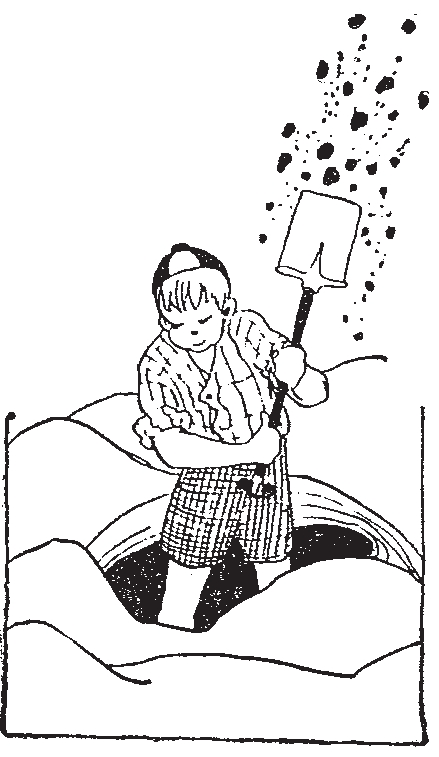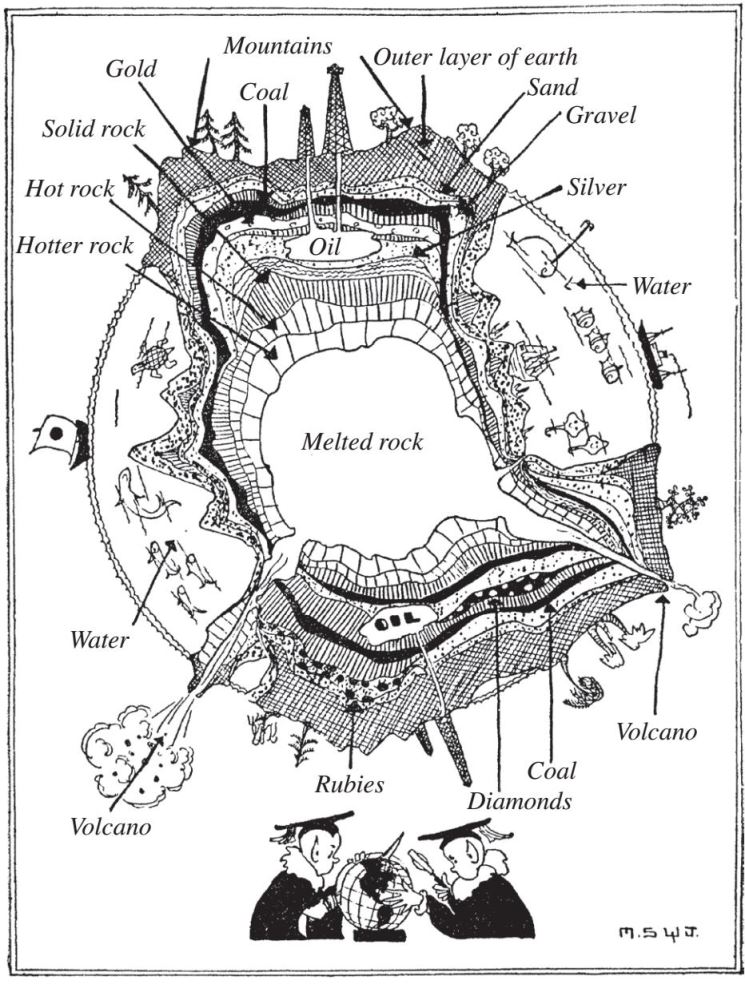




 03 The Inside of the World
03 The Inside of the World
wheN I was a very little boy I was very inquisitive. At least, that’s what my nurse called me.
One day when I was walking with her along the city pavements, I asked:
“Jane, what’s under the pavement?”
“Oh, just dirt,” she replied.
“And what is under the dirt?”
“Oh, more dirt,” she replied.
“Well, what’s under that?” I asked. I wasn’t satisfied.
“Oh, nothing—I don’t know—why are you always so inquisitive?” she asked.
I knew there must be something underneath that, and I just wanted to know what it was—I was just inquisitive.
I had heard that the place bad boys went when they died was down under the ground somewhere—a big cave,perhaps—and I wanted to know if that were so.
And then I had heard that all the way through on the other side of the World Chinamen lived, head down, and walked upside down like flies on the ceiling. I wanted to find out if that were so too.
So I made up my mind I’d dig down through the World;down, down, down, till I came through on the other side,and then I’d know. I was a very little boy, you see. With a tin shovel I started a hole in the back yard behind the grapevines, where no one would know what I was doing. I wanted to keep it a secret until I had dug all the way through. Day after day I worked, digging up first soft ground —that was easy—then I got down to solid ground; that was hard.I had a hole which I could stand in up to my waist.
Then one evening my father asked,“What’s that hole in the back yard?”
My secret was out. He didn’t laugh when I told him—at least, out loud—

With a tin

but he asked me if I knew how far I’d have to dig.
“Could you dig down as deep as the Washington Monument goes up?” he asked.
I thought perhaps I could, but I was a little doubtful, for the Washington Monument seemed terribly high.
“Men have dug wells many times as deep as the Washington Monument,” my father told me, “but never all the way nor nearly all the way through the World. You would have to dig many thousands of times deeper than the Washington Monument to get down even to the center of the World. It’s eight thousand miles straight through the earth and most all the way is rock—just rock, and more rock, that’s all.”
Then I gave it up.
“How do you know it’s eight thousand miles if no one has ever been through the World?” asked the inquisitive child. I don’t know what my father answered. I was too young to understand. I wonder if you are too young, if I tell you how we know it’s eight thousand miles; for without ever having been through the World, we do know how far it is.

This is how we know. It’s a funny thing, but every ball,whether it is a little ball or a medium-sized ball or a great big ball, is always just a little more than three times as big round as it is through. I have often wondered why this was so—why a ball shouldn’t be exactly three times or four times or five times as big round as through, but it isn’t. You can try it yourself if you don’t believe it. Take an apple or an orange and measure it around and then cut it and measure it through.
Now we know the World is a ball, a huge ball, and yet as it is a ball it must, like all other balls, be a little more than three times as big around as it is through. It is twenty-five thousand miles round the World, because men have actually measured that. So we know that the distance through must be about eight thousand miles, as twenty-five is a little more than three times eight. That is not geography; it’s arithmetic.If you want to use big words for “around” and “through,”as they do in geographies, you must say “circumference” for“around” and “diameter” for “through”—which mean the same thing: the circumference of the World is twenty-five thousand and the diameter is eight thousand.
The outside of the World is a crust of rock like the skin of a baked potato over the hot inside. Some of the crust that you go through first is in layers, like layers in a jelly-cake, one layer after another, only these rock layers look as if they were made of sand and shells, or coal or little stones, and that’s what they are made of. If you could cut the World in half as if it were an apple, it might look something like the picture on the next page. We call it a “Cross Section.”
Between some of the layers of rock there is coal like jelly in a jelly-cake and in other places there are gold and silver and diamonds and rubies, and in some of the rock there are pools of oil. That’s why men dig wells down through these layers of rock to get oil, and that’s why men dig mines to get coal and gold.
And still farther down the rock is not in layers—it is just solid rock; and still farther down it gets hotter and hotter where the world has not cooled off even yet, until the rock is no longer solid, but melted.
Whenever you see a chimney you know there is a furnace beneath it, and when smoke and fire come out of its top you know there is a fire in the furnace. Well, there are many places on the World where fire and smoke come out of the ground as if’ through a chimney from a fiery furnace. These places are called volcanoes.
Why was the World made of rock instead of brass or glass or china? Why is the World shaped like a ball and not like a box, a roller, or an old shoe?